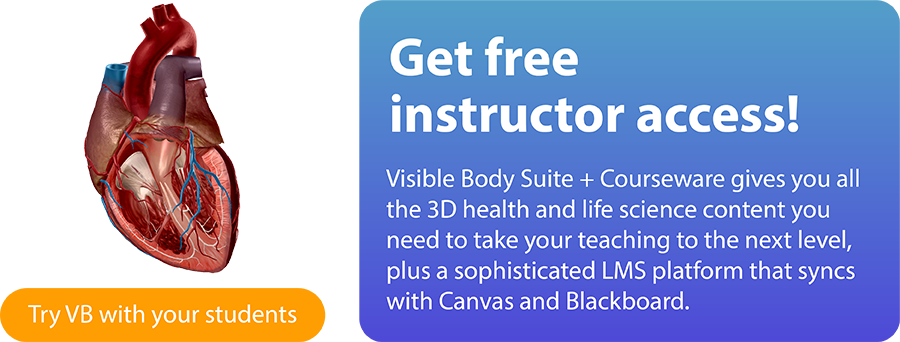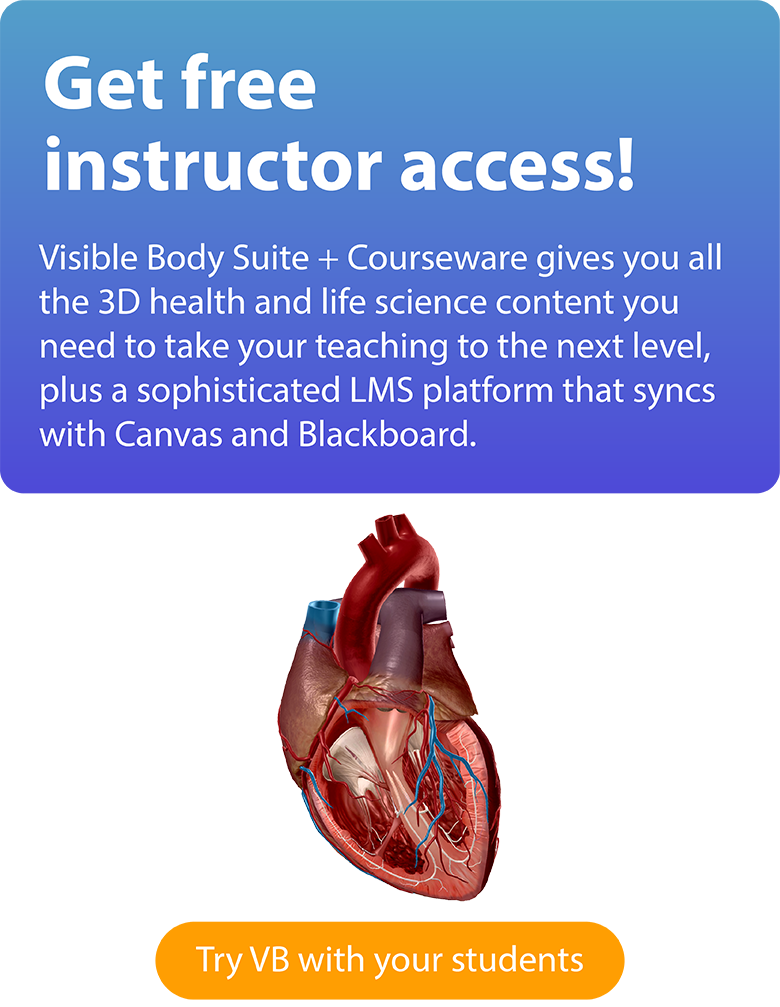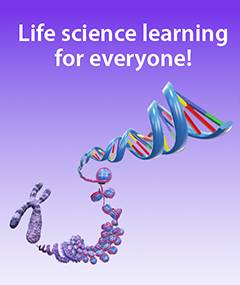5 Endocrine Hormone Activities for Your Classroom
Posted on 3/28/25 by Sarah Boudreau
As the body’s “chemical messengers,” endocrine hormones affect almost every organ and are crucial to countless body functions. In this blog post, we’ll show you resources you can use to teach the endocrine system in 3D, followed by five activities and discussions on endocrine hormones that you can use in your classroom. To build these activities, we will pull information from the A&P textbook created by our friends at OpenStax.
Let’s get started!


3D Teaching Resources
To fully understand endocrine hormones and their effects, students need to understand the basics of the endocrine system. With 3D visualizations, animations, and interactive assignments in Visible Body Suite and Courseware, instructors have all the quality content they need to engage their students.
In VB Suite, you can find interactive 3D models of the endocrine system, including:
- Views that cover all endocrine organs
- A microanatomy model of the hypothalamus and pituitary gland
- Models for endocrine system pathologies: PCOS and type 1 diabetes
- Microanatomy models of the ovary and testis

GIF from the A&P bootcamp in VB Suite.
VB Suite also contains bite-sized animations covering topics from positive feedback loops to lactation.
Through Courseware, Visible Body’s teaching and learning platform, instructors can assign immersive premade content or create their own. Within Visible Body’s library of premade content, instructors can find:
- Interactive, self-grading assignments that cover an introduction to the endocrine system, hormone action and regulation, and endocrine organs and functions, as well as a cumulative assessment
- A self-grading virtual lab walking students through endocrine organ anatomy
- Premade Flashcard Decks covering endocrine organs and functions, the hypothalamus and pituitary, pancreatic acini and islets, and the ovary

Premade assignment in Courseware.
Flashcard Deck
For students, flashcards are a time-honored tradition. They are also a great way to quickly memorize information. Have your students create a short flashcard deck with the name of the hormone(s) on one side and the associated endocrine gland, chemical class, and effect on the other side.
Here’s a useful table from OpenStax:
|
Endocrine gland |
Associated hormones |
Chemical class |
Effect |
|
Pituitary (anterior) |
Growth hormone (GH) |
Protein |
Promotes growth of body tissues |
|
Pituitary (anterior) |
Prolactin (PRL) |
Peptide |
Promotes milk production |
|
Pituitary (anterior) |
Thyroid-stimulating hormone (TSH) |
Glycoprotein |
Stimulates thyroid hormone release |
|
Pituitary (anterior) |
Adrenocorticotropic hormone (ACTH) |
Peptide |
Stimulates hormone release by adrenal cortex |
|
Pituitary (anterior) |
Follicle-stimulating hormone (FSH) |
Glycoprotein |
Stimulates gamete production |
|
Pituitary (anterior) |
Luteinizing hormone (LH) |
Glycoprotein |
Stimulates androgen production by gonads |
|
Pituitary (posterior) |
Antidiuretic hormone (ADH) |
Peptide |
Stimulates water reabsorption by kidneys |
|
Pituitary (posterior) |
Oxytocin |
Peptide |
Stimulates uterine contractions during childbirth |
|
Thyroid |
Thyroxine (T4), triiodothyronine (T3) |
Amine |
Stimulate basal metabolic rate |
|
Thyroid |
Calcitonin |
Peptide |
Reduces blood Ca2+ levels |
|
Parathyroid |
Parathyroid hormone (PTH) |
Peptide |
Increases blood Ca2+ levels |
|
Adrenal (cortex) |
Aldosterone |
Steroid |
Increases blood Na+ levels |
|
Adrenal (cortex) |
Cortisol, corticosterone, cortisone |
Steroid |
Increase blood glucose levels |
|
Adrenal (medulla) |
Epinephrine, norepinephrine |
Amine |
Stimulate fight-or-flight response |
|
Pineal |
Melatonin |
Amine |
Regulates sleep cycles |
|
Pancreas |
Insulin |
Protein |
Reduces blood glucose levels |
|
Pancreas |
Glucagon |
Protein |
Increases blood glucose levels |
|
Testes |
Testosterone |
Steroid |
Stimulates development of sex characteristics including a deeper voice, increased muscle mass, development of body hair, and sperm production |
|
Ovaries |
Estrogens and progesterone |
Steroid |
Stimulate development of sex characteristics including the development of adipose and breast tissue, and prepare the body for childbirth |
If your classroom uses VB Suite, you can ask your students to create their own study materials with Flashcard Decks! As they create their Flashcards, users annotate and tag 3D views, flipping their cards with a click or a tap. Since Flashcards are saved to the user’s account, students can access their Flashcards on their desktop or mobile device for studying on the go.

Flashcard in VB Suite. Flashcard Decks are also assignable in Courseware!
To create hormone Flashcards, students should first navigate to a model that shows the endocrine gland that produces the hormone. Next, they can click on the Flashcard button on the bottom toolbar to start creating their Flashcard! Using the text feature, they can add the name of the hormone on one side of the card and its class and effect on the other.
Flashcard Decks are shareable with a few quick clicks, so you can turn this activity into a graded assignment, like this bony landmarks assignment.
Hormone Card Sorting
This activity is inspired by Dr. Cindy Harley’s card sorting tasks, like the one we talk about in this renal system teaching guide.
For this activity, write the names of the major hormones on an index card or simply print and cut them out from this PDF. Then, students will work in pairs and small groups to perform a series of sorting activities.
You can ask students to sort the cards by which gland produces the hormone, by the hormone’s chemical class, or another property, like whether or not they use positive or negative feedback.
Next, use the card sorting activities as a launching point for discussion:
- What are similarities and differences between amine, peptide and protein, and steroid hormones?
- How do steroid hormones travel through the bloodstream differently?
Hormone Receptor Comics
Hormone receptors are located either within a cell or on its surface, which means that cells receive communication signals in different ways. This activity will help students remember how intracellular and cell membrane hormone receptors function.
Start with a discussion—ask your students why they think some hormones require receptors on the cell membrane, while others use receptors within the cell. What about the hormones’ makeup enables them to reach intracellular receptors?
For this activity, students will create two short comics that walk through how hormones communicate through intracellular and cell membrane hormone receptors.
Why a comic? Comics tell a story, and through a story, we can break concepts down into incremental steps. Representing these processes in graphic form challenges students to use higher order thinking to best represent the concepts.
Make sure to emphasize that this isn’t an art competition—no one will be judged on their artistic prowess.
Click here for printable activity sheets!

For the comic on intracellular hormone receptors, students should use five panels to express the following steps:
- The hormone binds to transport proteins
- The hormone is released from the transport protein and diffuses through the cell membrane
- The hormone binds to the receptor within the cytoplasm (or nucleus)
- The receptor-hormone complex enters the nucleus, triggering transcription
- In the cytosol, mRNA is translated into proteins
To illustrate cell membrane hormone receptor pathways, use cAMP. This will require six panels:
- The hormone binds to a receptor on the exterior of the cell membrane
- G-protein is activated
- G-protein activates adenylyl cyclase
- Adenylyl cyclase converts ATP to cAMP
- cAMP activates protein kinase in the cytosol
- The protein kinase phosphorylates proteins
Hormone Profile
In this activity, students will create a hormone profile that displays key information about their assigned hormone.

Hormone profile example.
Here is a PDF with Instagram-style profile templates that are ready to be printed and filled out.
Students should write their hormone’s name at the top and fill in the circle with a creative depiction of the hormone—students can get creative here and draw the hormone’s chemical makeup or effect, the gland that produces it, or another representation. Then, they will fill in the boxes at the bottom with the hormone’s effect, gland, and chemical class.
This part of the activity should not take long to complete. When the students are done, it’s time for a “gallery walk,” where students walk around and examine their peers’ work.
After the gallery walk, ask your students to share what they noticed about the different hormones. Students should observe that some hormones seem to have opposite effects on the body—for example, insulin and glucagon.
This is a great jumping-off point to discuss permissive, synergistic, and antagonistic effects.
Discuss Applications
In addition to increasing engagement, discussing “real world” applications for classroom knowledge reinforces information and helps students make connections between concepts.
Lead a brief classroom discussion on the topic of endocrine-disrupting hormones (known as EDCs). EDCs are compounds that interfere with the body’s hormones and their regulation. Many products in stores today contain EDCs. Here are some examples:
- Bisphenol A (BPA), a compound used in plastics, may be the most well-known EDC. Many plastic products in stores now contain “BPA free!” labels.
- Atrazine is one of the most-used herbicides in the world. Harmful to multiple body systems, it primarily poses a risk to farmers.
- Per- and polyfluoroalkyl substances (PFAS) are a group of chemicals found in thousands of everyday products, including non-stick cookware. They are connected to many adverse health effects, including a possible delay in puberty for girls.
Discussion questions:
- What challenges do you think researchers face when studying the impact of EDCs?
- Which groups are more likely to be affected by EDCs?
- Have you encountered any EDC-related health messaging in your day-to-day life?
Wrap-up
We hope that you found these endocrine hormone activities useful! If you’re interested in more lesson plans, subscribe to the blog or browse our lesson plan tag.
In case you missed them, here are the three activity PDFs that correspond with the activities in this blog post:
Happy teaching!
Be sure to subscribe to the Visible Body Blog for more anatomy awesomeness!
Are you an instructor? We have award-winning 3D products and resources for your anatomy and physiology course! Learn more here.



